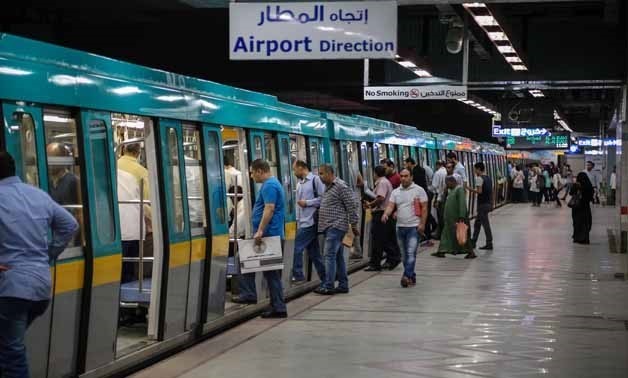
Cairo's Attaba Metro Station - Photo by Karim Abdel Aziz/Egypt Today
CAIRO – 22 May 2018: The third phase of line 3 of the Cairo metro will be connected to the Rod Al-Farag axis, which links the Greater Cairo with El Dabaa and Marsa Matrouh.
An interchange station will be established at the end of third line, linking the third line to the Rod Al-Farag axis (Greater Cairo-El Dabaa). This interchange station will also be connected to the electric train project.
The two-way Rod Al-Farag axis connects north and east Cairo to west Cairo at the Cairo Alexandria Desert Road and connects Red Sea Coastal Road to the new Galala Road with Mediterranean Sea Coastal Road; it contains six lanes, as well as two lanes for buses and an electric metro train line.
On Wednesday, the prime minister will witness the drilling process of the third phase of line 3, which includes 15 stations constructed by the Egyptian-French alliance led by Vinci.
The third phase of line 3 will connect the working-class districts of Attaba, Bulaq and Imbaba with Cairo University in Giza. The phase will also pass through well-off neighborhoods like Zamalek, Mohandiseen and Agouza. The construction work on the 18-kilometer phase officially started in 2017.
Additionally, the fourth phase runs from Haroun station to Heliopolis Square, while the first one is from Attaba to Abbasiya and the second phase is from Fair Zone to Ahram.
At the same time, Egypt’s underground also has the other original two lines: the first runs from Al-Marg to Helwan, while the second runs from Shubra to Giza.
Starting May 11, the Ministry of Transportation increased the fare of metro tickets based on the length of each commute.
The new fares are LE 3 ($0.17) for the first nine stops, LE 5 for up to 16 stops and LE 7 for more than 16 stops.
Before increasing the metro’s fare, the price of the underground tickets had previously been doubled in July 2017 from LE 1 to LE 2 as part of reforms that cut subsidies after the inflation.
Reasons behind increasing metro prices
The government decided to increase the fare of metro tickets after the underground subway system incurred financial losses worth millions of pounds, which had resulted in poor maintenance on the second and third lines.
In this regard, Minister of Transport Hisham Arafat said that hiking metro ticket prices is essential to finance and upgrade the infrastructure of the metro’s first line, which needs LE 30 billion for renovation, and implement the development plan for Cairo’s underground metro.
He added that it also aims to cover the losses of the underground, and despite the increase in ticket prices, the state still subsidizes the metro ticket and bears LE 9 of the actual price of tickets so that citizens can get access to any station for LE 7, while the fair value of the ticket is LE 16.
He referred that Egypt is still considered among the cheapest countries in regard to prices of metro tickets, stressing that even ministers pay for their own tickets when they take the metro.
Arafat also denied rumors that underground metro train drivers get EGP 12,000 per month, pointing out that senior drivers receive only EGP 8,500.
To start developing Cairo’s metro, the National Authority for Tunnels (NAT) launched a tender on May 19 for international companies to offer their bids for providing six new air-conditioned trains and two tractors for the second line of the metro linking between Shubra and Moneeb.
The project of constructing the metro’s second line is financed by the European Bank for Reconstruction and Development, which will provide Egypt with a concessional loan worth €100 million ($118 million).
NAT has set July 8 as the deadline for receiving bids from all companies.
Metro passengers protest over increasing prices
Following the fare hike on Friday, May 11, videos and photos circulated on social media showing passengers jumping turnstiles to protest the hike, along with calls to boycott the service. They also demonstrated in some stations against what they chanted as the “unaffordable increase of metro prices.”
In response, the Interior Ministry deployed police officers in underground stations and arrested 21 protesters who took part in the demonstrations. Ten of them were released on May 15.

Comments
Leave a Comment